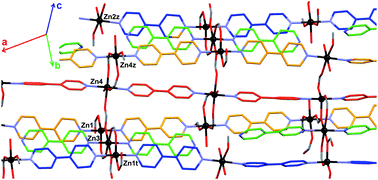The combination of a [zinc(II)–4,4′-bpy] coordination moiety with, respectively, formato, acetato and propionato ligands leads to the formation of the compounds {[Zn3(4,4′-bpy)3.5(µ-O2CH)4 (H2O)2](ClO4)2(H2O)2}n (1), {[Zn3(4,4′-bpy)3(µ-O2CCH3)4(H2O)2](PF6)2(H2O)2}n (2) and {[Zn3(4,4′-bpy)4(µ-O2CCH2CH3)4](ClO4)2(4,4′-bpy)2(H2O)4}n (3). The molecular structures determined by single-crystal X-ray diffraction data reveal significant changes, which are apparently due to the sole different steric hindrance between a H atom (formato, compound 1), a methyl group (acetato, compound 2) and an ethyl group (propionato, compound 3). The three coordination materials have been fully characterized and their thermal decomposition behavior has been investigated. The 3D (1), 1D (2) and 2D (3) networks exhibit voids that contain the counter-ions and guest molecules as well, namely water for compounds 1 and 2, and water/4,4′-bpy for compound 3.


 Please wait while we load your content...
Please wait while we load your content...